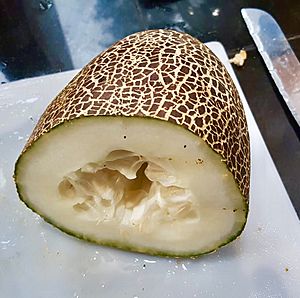Hmong cuisine facts for kids
Hmong cuisine is the food eaten by the Hmong people. You can find Hmong communities in places like China, Southeast Asia, and the United States.
Most Hmong dishes aren't totally unique to the Hmong. Instead, they are a mix of foods from different cultures where Hmong people have lived. As the Hmong moved around after leaving ancient China, they adopted popular dishes from countries like Laos, Thailand, Vietnam, and China.
Contents
What is Hmong Cuisine?
Hmong food can be a bit different depending on where you are. For example, in Hmong communities in the United States, a Hmong dish might be very similar to a dish from Chinese, Lao, Vietnamese, or Thai food. Many Hmong people traveled through Laos and Thailand to get to their new homes around the world. Because of this, Lao food has really influenced some Hmong dishes.
Even though the ingredients in these adopted dishes don't change much, the way they are prepared might be quicker. This was helpful in mountainous areas where many people in a village needed to eat quickly. In cities, Hmong dishes often look like other Asian foods. A big difference is that Hmong people love to add extra sauces and toppings. For example, they might add lots of sugar and soy sauce to pho, which is a famous Vietnamese soup.
For a long time, the Hmong language wasn't widely written down. This meant that Hmong cooking traditions were passed down by older family members. Real Hmong dishes were taught by word of mouth and could be different from one family or group to another. These differences often depended on where the family lived and what ingredients they could find.
Hmong restaurants are rare in Asia, but they have become more common in countries where Hmong people have moved. These restaurants are usually owned by Hmong families. However, the food on their menus often isn't seen as specific to Hmong cuisine. Instead, you might find popular East and Southeast Asian dishes labeled as "Hmong." For instance, "Hmong Chicken Wings" are a common appetizer. These chicken wings are usually marinated in many of the spices that Hmong people enjoy in other dishes.
Key Ingredients in Hmong Food
The main food for Hmong people is white rice. They usually eat it with different vegetables, hot peppers (often in a Southeast Asian-style sauce), and boiled or fried meat if it's available. Sticky rice, which can be white or purple, is often served at parties and on special days.
Hmong cuisine uses many different spices and herbs, similar to Vietnamese, Thai, and Laotian cooking. These include hot peppers (like Thai chilies), lemongrass, cilantro, garlic, green onions, mint, galangal, and ginger. Sauces like fish sauce, oyster sauce, soy sauce, sriracha sauce, and hoisin sauce are also used a lot.
Hmong Egg Rolls
Traditional "Hmong" egg rolls are linked to Vietnamese egg rolls. This connection comes from the time Hmong people migrated across Asia. These crispy, fried rolls wrapped in thin dough are often found at family gatherings and special events like the Hmong New Year. In Rhode Island, the Hmong community even holds a yearly event where they sell traditional Hmong egg rolls to raise money.
Each family has its own special recipe for egg rolls. But usually, they are made with eggs mixed with shredded carrots and cabbage, ground pork, onions, green onions, and cilantro. These ingredients are seasoned with oyster sauce, rolled into a thin wheat wrapper, and then deep-fried until golden and crispy.
Hmong Meal Times
Hmong people usually eat three meals a day and don't often snack in between. Each meal includes white rice, and usually vegetables and a smaller amount of meat. The meat and vegetables are often stir-fried, steamed, or boiled. Hot pepper sauce (called kua txob) is almost always served on the side with most meals, just like in many other Asian cuisines.
The types of food prepared for different meals don't change much. However, breakfast and dinner often have more effort put into them. This is because Hmong people often had limited ingredients during their past migrations. This way of eating has been accepted and is now a part of Hmong culture. Meals are eaten together, with food placed in the center for everyone to share. At large cultural gatherings, men traditionally eat first, followed by women and children. This custom is still followed by those who keep traditional Hmong ways.
Naab Vaam: A Sweet Treat
Naab Vaam (pronounced Nah-vah) is a traditional Hmong drink. It's sometimes served during special events. In English, it's sometimes called "Tri-Color" because of its different layers. Naab Vaam is a sweet dessert drink that includes coconut, tapioca pearls, cendol (green jelly noodles), and many other toppings mixed in.
In Hmong culture, it's important to have toppings like colored chestnuts, jello, sweet fruit, and grass jelly in Naab Vaam. Many of these toppings can be made from scratch using sugar, coconut milk, and rice flour.



